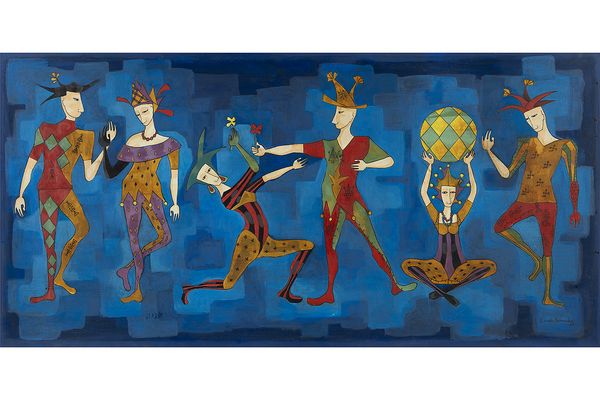Cundo Bermúdez, Untitled, 1960. Modern & Contemporary Art: Online Auction, New York.
Geometric Abstraction
Mauricio Nogueira Lima

Maurício Nogueira Lima, Geométrico, circa 1960. Modern & Contemporary Art: Online Auction, New York.
Lurking beneath this remarkably balanced, geometric, and mesmerizing composition is the story of a visionary Brazilian artist. Maurício Nogueira Lima came of age in the late 1940s and 1950s, studying at the Institute of Fine Arts at the University of Rio Grande do Sul, before settling in São Paulo and finding early success in commercial advertising design. A graphic approach informed his fine art practice as well, and in 1953 he joined the aesthetically progressive Grupo Ruptura of Rio de Janeiro, which pushed Brazilian culture to accept Modern Art, specifically embracing Concrete Art as a break from the painting styles prevalent in the country at the time. Lima exhibited widely with the group throughout the 1950s, both in Brazil and Zurich. He was chosen to represent Brazil at the Venice Biennale in 1954, ultimately declining the invitation as it was not also extended to the entire Grupo Ruptura. Emblematic of his characteristic style and executed during this fervently creative midcentury period, Geométrico employs pure, abstract shapes to create a deceptively simple composition that holds the gaze.
Ivan Serpa

Ivan Serpa, Untitled from Séria Geomântica, 1972. Modern & Contemporary Art: Online Auction, New York.
Artist and polymath Ivan Serpa was an accomplished painter, printmaker, draftsman, and designer, whose strong reputation led him to a teaching appointment at the Museu de Arte Moderna do Río de Janeiro (MAM). From this post, he held open studio sessions for young adults in Rio, eventually becoming a mentor to prominent young Brazilian artists, including the founders of Grupo Frente — a collective of young artists interested in Concrete Art. His approach to teaching was open and democratic, allowing for fruitful creative exploration and echoing social movements proliferating in Brazil at the time. Largely self-taught, Serpa’s intuitive approach to art-making found international acclaim and his work was included in the 1962 Venice Biennale and further group exhibitions throughout South America, the United States, and Europe. Often working in series, Serpa embraced a grid-like, architectural approach to geometric abstraction, of which the present work is a shining example.
Lolo Soldevilla
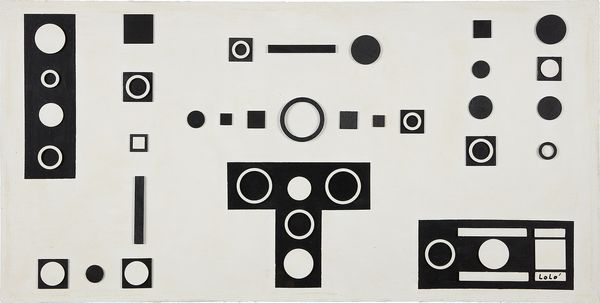
Lolo Soldevilla, Sin título, N.d. Modern & Contemporary Art: Online Auction, New York.
The daughter of a piano teacher and a merchant, Lolo Soldevilla was a musician, political activist, and party politician before embracing visual art making in a career that blossomed through the 1950s. She was appointed as a diplomat to Europe in 1949, traveling to Paris. On return to Havana, she assumed a large role in the local art scene as an artist, curator, and gallery owner, founding the Galeria de Arte Color Luz. The gallery was crucial in the development of abstract art in Cuba and held a pioneering exhibition of Concrete Art in the late ‘50s. Her mixed media work on offer here showcases her approach to geometric abstraction, and even subtly showcases her background as a musician, bearing a striking resemblance to graphic scores by Musique concrete composers.
Figurative Art
Cundo Bermudez
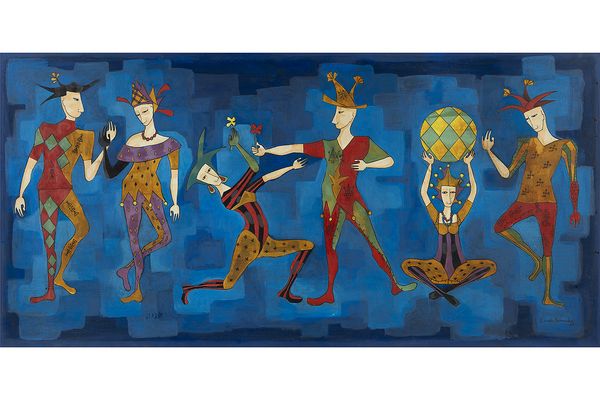
Cundo Bermúdez, Untitled, 1960. Modern & Contemporary Art: Online Auction, New York.
Striking in their humor and charm, Cuban artist Cundo Bermúdez’s works speak with a wit that has been highly lauded. Born in Havana, Bermúdez studied painting there at the Alejandro School of Fine Art, later traveling to Mexico City to study drawing at the San Carolos Academy of Fine Art. His reputation grew in the mid-20th century and his work was exhibited throughout the United States, Europe, and Central and South America. In this untitled gouche and acrylic work, the geometrically layered tones of rich blue and elongated forms of the jester figures showcases the delightful magnetism that draws viewers to Bermúdez’s works. Two of his works are held in the permanent collection of MoMA and many more are in the collection of the Museo Nacional de Bellas Artes de La Habana.
Angel Botello
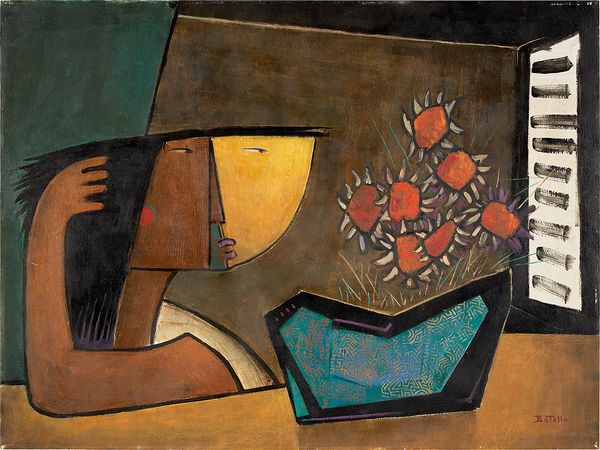
Angel Botello, Girl with Flowers, circa 1979. Modern & Contemporary Art: Online Auction, New York.
Known as the “Caribbean Gaugin” due to his use of bold colors, outlined forms, and his visual exploration of island culture, Spanish-born painter and sculptor Angel Botello spent the majority of his life living in the Dominican Republic, Cuba, Haiti, and Puerto Rico. Born in 1913, he moved to Bordeaux, France, in his youth and studied at the School of Fine Arts there before returning to Spain for studies at the School of Art of the San Fernando Academy. Leaving Spain at the onset of the Civil War, he eventually settled in the Dominican Republic where the local community of artists included him in exhibitions. He passed the ultimate decades of his life in Puerto Rico, capturing the bright spirit of the islands on canvas until his death in 1986.
René Portocarrero

René Portocarrero, Payaso con parasol, 1957. Modern & Contemporary Art: Online Auction, New York.
Pioneering Cuban artist René Portocarrero is lauded for his idiosyncratic and strong sense of line and color, of which Payaso con parasol is highly emblematic. His approach drew on the Spanish influences on Latin American culture and Mexican Muralism, with further influences from French Modernism. Achieving widespread acclaim throughout his career, a series of Portocarrero’s paintings featuring a female face adorned with flowers were presented at the 1966 Venice Biennale. Several of his works are held in the permanent collection at MoMA and the artist enjoyed a flourishing cultural reputation in Cuba during his life, even serving as an informal cultural advisor to Fidel Castro.
More to Explore
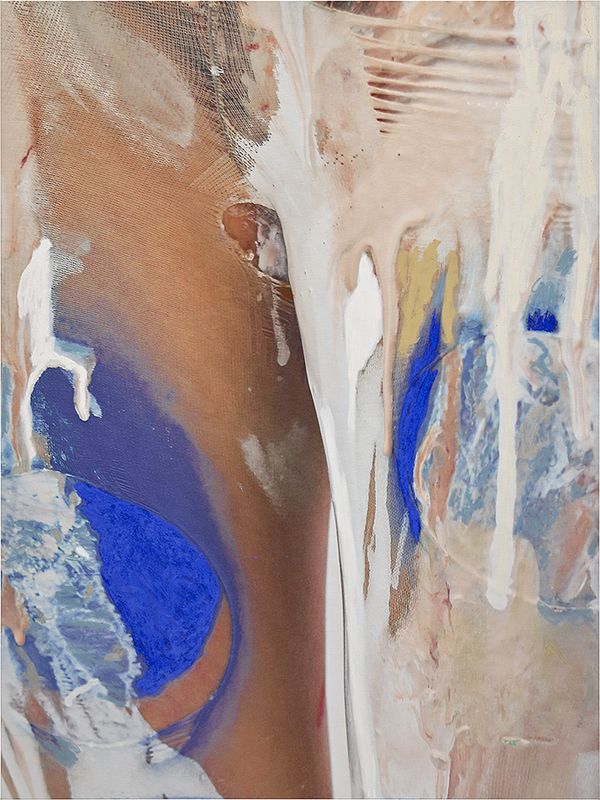
Donna Huanca, catalyst (WET), 2016. Modern & Contemporary Art: Online Auction, New York.
From American-born artists of Latin American descent like Donna Huanca and Caio Fonseca to artists including Federico Uribe, Alexandre Arrechea, Roberto Matta, and Antonio Berni, there are countless works to explore in the auction that shine a light on the rich cultural tapestry of the region.
